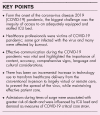Surging ICU during COVID-19 pandemic: an overview
- PMID: 36226716
- PMCID: PMC9612411
- DOI: 10.1097/MCC.0000000000001001
Surging ICU during COVID-19 pandemic: an overview
Abstract
Purpose of review: The coronavirus disease 2019 (COVID-19) pandemic has posed great challenges to intensive care units (ICUs) across the globe. The objective of this review is to provide an overview on how ICU surging was managed during COVID-19 pandemic, with a special focus on papers published in the last 18 months.
Recent findings: From the onset of the COVID-19 pandemic, it was apparent that the biggest challenge was the inequity of access to an adequately equipped and staffed ICU bed. The first wave was overwhelming; large surge of patients required critical care, resources were limited and non-COVID-19 care processes were severely compromised. Various approaches were used to address ICU staffing shortage and to expand the physical ICU space capacity. Because of restrictions to family visitations in most ICUs, the pandemic posed a threat to communication and family-centered ICU care. The pandemic, especially during the first wave, was accompanied by a high level of apprehension in the community, many uncertainties about clinical course and therapy and an influx of speculations and misinformation.
Summary: Although healthcare systems learned how to face some of the challenges with subsequent waves, the pandemic had persistent effects on healthcare systems.
Copyright © 2022 Wolters Kluwer Health, Inc. All rights reserved.
Conflict of interest statement
Similar articles
-
Assembly Line ICU: what the Long Shops taught us about managing surge capacity for COVID-19.BMJ Open Qual. 2020 Dec;9(4):e001117. doi: 10.1136/bmjoq-2020-001117. BMJ Open Qual. 2020. PMID: 33277292 Free PMC article.
-
A country-level analysis comparing hospital capacity and utilisation during the first COVID-19 wave across Europe.Health Policy. 2022 May;126(5):373-381. doi: 10.1016/j.healthpol.2021.11.009. Epub 2021 Dec 1. Health Policy. 2022. PMID: 34924210 Free PMC article.
-
How COVID-19 has affected staffing models in intensive care: A qualitative study examining alternative staffing models (SEISMIC).J Adv Nurs. 2022 Apr;78(4):1075-1088. doi: 10.1111/jan.15081. Epub 2021 Nov 15. J Adv Nurs. 2022. PMID: 34779532
-
A Year of Critical Care: The Changing Face of the ICU During COVID-19.Methodist Debakey Cardiovasc J. 2021 Dec 15;17(5):31-42. doi: 10.14797/mdcvj.1041. eCollection 2021. Methodist Debakey Cardiovasc J. 2021. PMID: 35855452 Free PMC article. Review.
-
ICU preparedness in pandemics: lessons learned from the coronavirus disease-2019 outbreak.Curr Opin Pulm Med. 2021 Mar 1;27(2):73-78. doi: 10.1097/MCP.0000000000000749. Curr Opin Pulm Med. 2021. PMID: 33332879 Free PMC article. Review.
Cited by
-
Analysis of prognostic factors in critically ill patients with COVID-19.PLoS One. 2024 Jun 27;19(6):e0302248. doi: 10.1371/journal.pone.0302248. eCollection 2024. PLoS One. 2024. PMID: 38935767 Free PMC article.
-
High-flow nasal oxygen therapy compared with conventional oxygen therapy in hospitalised patients with respiratory illness: a systematic review and meta-analysis.BMJ Open Respir Res. 2024 Jul 15;11(1):e002342. doi: 10.1136/bmjresp-2024-002342. BMJ Open Respir Res. 2024. PMID: 39009460 Free PMC article.
-
Comparison of factors influencing the decision to withdraw life-sustaining treatment in intensive care unit patients after implementation of the Life-Sustaining Treatment Act in Korea.Acute Crit Care. 2024 May;39(2):294-303. doi: 10.4266/acc.2023.01130. Epub 2024 May 24. Acute Crit Care. 2024. PMID: 38863360 Free PMC article.
-
Optimal Timing of Tracheostomy in the Setting of COVID-19 and Associated Pneumothorax.Cureus. 2024 Mar 4;16(3):e55479. doi: 10.7759/cureus.55479. eCollection 2024 Mar. Cureus. 2024. PMID: 38444928 Free PMC article.
-
STEMI in Times of Crisis: Comparative Analysis During Pandemic and War.J Clin Med. 2025 Mar 4;14(5):1720. doi: 10.3390/jcm14051720. J Clin Med. 2025. PMID: 40095790 Free PMC article.
References
-
- Greco M, De Corte T, Ercole A, et al. . Clinical and organizational factors associated with mortality during the peak of first COVID-19 wave: the global UNITE-COVID study. Intensive Care Med 2022; 48:690–705. - PMC - PubMed
-
This was multicenter, international, point prevalence study of adult patients with COVID-19 admitted to ICUs between February 15th and May 15th, 2020. 4994 patients from 280 ICUs in 46 countries were included. The study demonstrated that ICUs increased their total capacity from 4931 to 7630 beds, deploying personnel from other areas. Overall, 1986 (39.8%) patients were admitted to surge capacity beds. In this study, admission to surge capacity beds was not associated with mortality, even after controlling for other factors. Older age, invasive mechanical ventilation, and AKI were identified as the strongest predictors of mortality.
-
- Kerlin MP, Costa DK, Davis BS, et al. . Actions taken by US hospitals to prepare for increased demand for intensive care during the first wave of COVID-19: a national survey. Chest 2021; 160:519–528. - PMC - PubMed
-
This study evaluated what actions did US hospitals take to prepare for a potential surge in demand for critical care services in the context of the COVID-19 pandemic.
Publication types
MeSH terms
LinkOut - more resources
Full Text Sources
Medical
Research Materials


